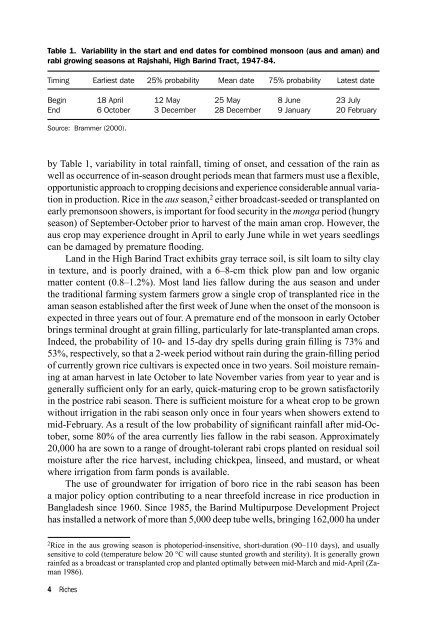Download (2461kB) - University of Greenwich
Download (2461kB) - University of Greenwich
Download (2461kB) - University of Greenwich
- No tags were found...
Create successful ePaper yourself
Turn your PDF publications into a flip-book with our unique Google optimized e-Paper software.
Table 1. Variability in the start and end dates for combined monsoon (aus and aman) andrabi growing seasons at Rajshahi, High Barind Tract, 1947-84.Timing Earliest date 25% probability Mean date 75% probability Latest dateBegin 18 April 12 May 25 May 8 June 23 JulyEnd 6 October 3 December 28 December 9 January 20 FebruarySource: Brammer (2000).by Table 1, variability in total rainfall, timing <strong>of</strong> onset, and cessation <strong>of</strong> the rain aswell as occurrence <strong>of</strong> in-season drought periods mean that farmers must use a flexible,opportunistic approach to cropping decisions and experience considerable annual variationin production. Rice in the aus season, 2 either broadcast-seeded or transplanted onearly premonsoon showers, is important for food security in the monga period (hungryseason) <strong>of</strong> September-October prior to harvest <strong>of</strong> the main aman crop. However, theaus crop may experience drought in April to early June while in wet years seedlingscan be damaged by premature flooding.Land in the High Barind Tract exhibits gray terrace soil, is silt loam to silty clayin texture, and is poorly drained, with a 6–8-cm thick plow pan and low organicmatter content (0.8–1.2%). Most land lies fallow during the aus season and underthe traditional farming system farmers grow a single crop <strong>of</strong> transplanted rice in theaman season established after the first week <strong>of</strong> June when the onset <strong>of</strong> the monsoon isexpected in three years out <strong>of</strong> four. A premature end <strong>of</strong> the monsoon in early Octoberbrings terminal drought at grain filling, particularly for late-transplanted aman crops.Indeed, the probability <strong>of</strong> 10- and 15-day dry spells during grain filling is 73% and53%, respectively, so that a 2-week period without rain during the grain-filling period<strong>of</strong> currently grown rice cultivars is expected once in two years. Soil moisture remainingat aman harvest in late October to late November varies from year to year and isgenerally sufficient only for an early, quick-maturing crop to be grown satisfactorilyin the postrice rabi season. There is sufficient moisture for a wheat crop to be grownwithout irrigation in the rabi season only once in four years when showers extend tomid-February. As a result <strong>of</strong> the low probability <strong>of</strong> significant rainfall after mid-October,some 80% <strong>of</strong> the area currently lies fallow in the rabi season. Approximately20,000 ha are sown to a range <strong>of</strong> drought-tolerant rabi crops planted on residual soilmoisture after the rice harvest, including chickpea, linseed, and mustard, or wheatwhere irrigation from farm ponds is available.The use <strong>of</strong> groundwater for irrigation <strong>of</strong> boro rice in the rabi season has beena major policy option contributing to a near threefold increase in rice production inBangladesh since 1960. Since 1985, the Barind Multipurpose Development Projecthas installed a network <strong>of</strong> more than 5,000 deep tube wells, bringing 162,000 ha under2Rice in the aus growing season is photoperiod-insensitive, short-duration (90–110 days), and usuallysensitive to cold (temperature below 20 °C will cause stunted growth and sterility). It is generally grownrainfed as a broadcast or transplanted crop and planted optimally between mid-March and mid-April (Zaman1986).Riches
















